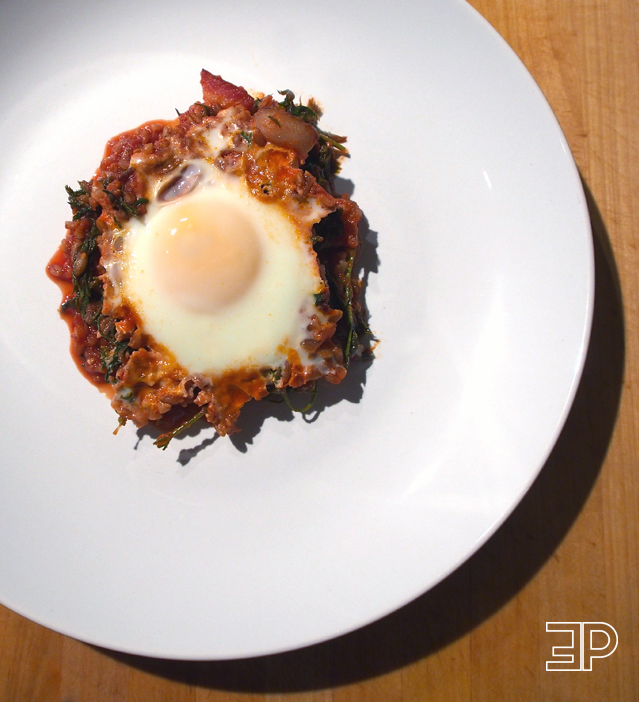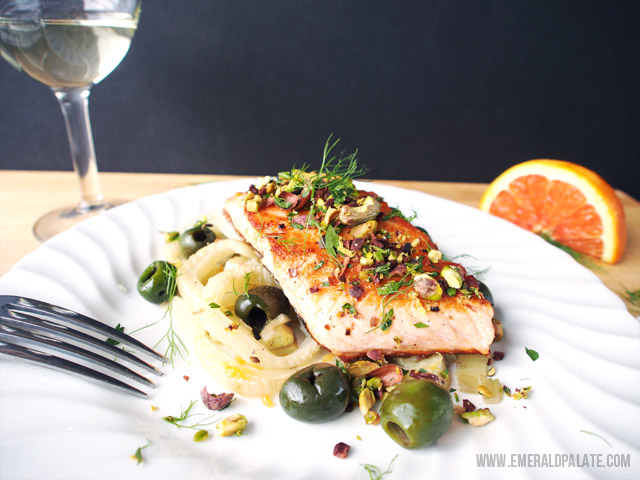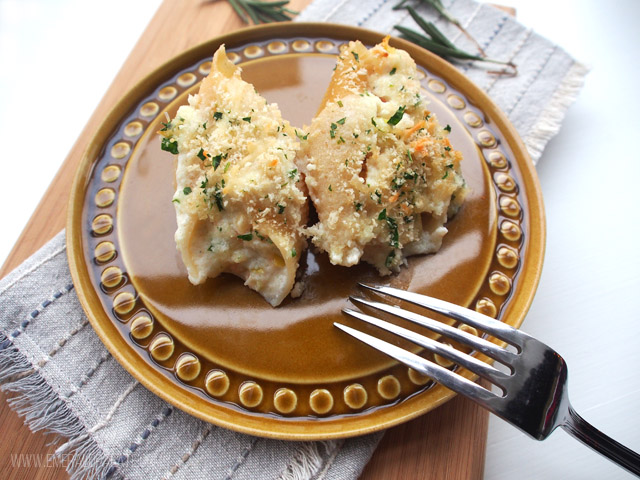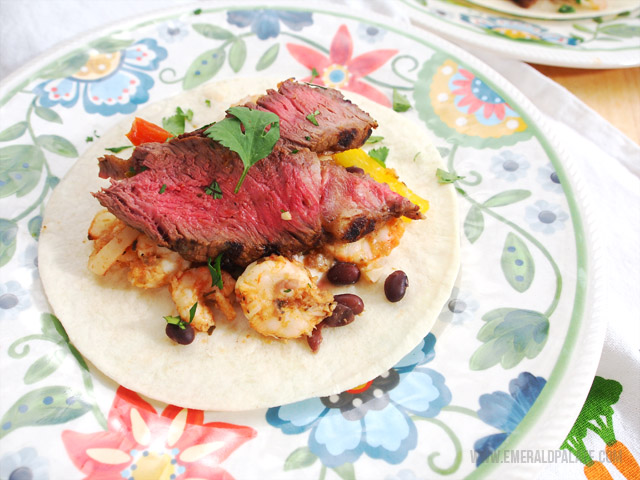
I’m a big fan of comfort food, but sometimes it’s difficult to build the complex flavors associated with these dishes in a short amount of time.
Take the fajita, for example. I absolutely love the flavor of the charred meats and veggies, packed with flavorful spices, rice, and beans. The problem is, I’m not going to make all of those components on a weeknight. No one’s got time for that.
That is, unless there’s a way to develop those satisfying flavors without the extra time. Lucky for us, there is a way! This fajita recipe outlines how you can get this Tex-Mex classic on the table in less than an hour. And the best part? It’s healthier than usual.
Creole Shrimp & Steak Fajita Recipe
February is American Heart Month, which is dedicated to raising awareness about heart disease. There’s been heart disease in my family, so I thought I’d share another healthy recipe for you to add to your meal rotation.
This recipe is also as easy as it is healthy. That’s because it features a creole-inspired sauce from Mesa de Vida, a company created by a local chef who had her own health scare at a young age. She turned things around for herself and became a personal chef to those looking to make a lifestyle change or stay fit. One of her clients you may have heard of: the Seahawks!
Read on to learn more about Mesa de Vida. Or go right to their website and use promo code EMERALD to get $4 off any purchase. Hurry, because it expires March 31, 2018!
About Mesa de Vida
I had the chance to chat with Mesa de Vida’s Sammamish-based founder, Kirsten Helle, to learn more about how she got started and what makes Mesa de Vida special. Here’s a snippet of our conversation.

When asked, “What is Mesa de Vida?”, what do you say?
Kirsten: Heart-healthy cooking sauces inspired by cultures all around the world.
People typically avoid cooking globally-inspired food or turn to packaged mixes to get that intense flavor, but these packages are full of salt and sugar. We’re here to bring more life to the table and help people have more exciting meals at home without all the artificial ingredients.
How did you get started?
Kirsten: I’ve been a personal chef since 2006. I got my start in catering, but thankfully I’m no longer doing that. I’m still a personal chef and launched my sauce line formally in December 2016.
I’ve been making these sauces for years for some of my players [Editor’s note: That’s Seahawk players]. It all got started when I was on my own health journey. I had to cut out processed food and was looking for ways to bulk up the food I was eating. I started making sofrito and fell in love with it.
Sofrito is a blend of veggies — usually tomatoes, onion, garlic, and bell peppers — that are sautéed down. I just love how the flavor comes through from the veggies. They bring so many characteristics to a dish. For example, caramelized carrots bring a little bit of bitter, sour and sweetness to the sofrito. The slow cooking of these veggies just enhances your dish so much.
At around the same time I was experimenting with sofritos, a lot of my pro clients’ doctors told me they needed to eat more veggies. I’d always call my clients my kids — they didn’t like to see their vegetables. Most of them are learning what healthy is for the first time. They’ve always been athletic and look healthy, but they’ve mostly been eating fast food.
So I started making these different flavor bases for them that had a ton of veggies.
A lot of my clients are from different areas of the world. So I asked them about what foods they love to eat. And what foods remind them of home. If it was an area I wasn’t familiar with, I’d study that cuisine and look for recipes for the foods they were talking about. I’d try to make them food that was authentic to the region, but also healthy and easy.
My sofrito became the base of these dishes. I’d play around with adding different spices and vegetables authentic to that cuisine my players craved. They loved it. They’d be eating veggies and didn’t know!
At first I was making them by the blender full. It took hours and cost $20 worth of spices each time, so I’d sometimes look for alternatives. But I found everything out there was loaded with sodium and sugar and highly processed.
I realized if I made my own every time, it would take hours and cost $20 worth of spices. So I started making it in batches, which I found actually helped intensify the herb flavor as they bloomed. One day when I didn’t have it already made, I found myself thinking, “I wish I just had some of my sauce in the cupboard.” And so the idea was born.
You mention your own healthy journey. Tell me more about that.
Kirsten: I grew up in a family where we loved food. We’re definitely all foodies. Both of my parents cooked most of the time. Food was central to our family and we often had a lot of vegetables from the garden growing up.
But my parents didn’t know what healthy was. They were both from farming families and if you put food on the table you’re doing a good job. We ate a lot of food growing up, and we always had convenience food because my parents worked. There was lots of Costco food — chips, bread, quick stuff we could make. I remember making instant pancake mix for breakfast most mornings. I was cooking it and thought I was so cool. But it still wasn’t healthy.
I grew up with all this delicious food, but with my metabolism, genetics, and our food choices, that meant I was heavy. Nobody in my family exercised. Growing up, I thought exercise was the tennis mom wearing tennis skirts and exercising all the time. I didn’t realize there was a middle ground where you, like, went for walks.
From 6 years old on, I was definitely chubby and always had health problems: bad knees, asthma…I thought it was normal. It was just the way my family was growing up. People in my family had health issues. A lot died early in their 50s and I just thought it was the way we were.
Growing up, I thought exercise was the tennis mom wearing tennis skirts and exercising all the time. I didn’t realize there was a middle ground where you, like, went for walks.”
And I remember trying to lose weight in high school because it was affecting my self esteem.
I was very closed off. I didn’t talk to a lot of people, and felt terrible. So I’d do Slim Fast or Lean Cuisine. I thought that was healthy, but I kept gaining weight. By the time I was 23 and had my daughter, I was obese. And I was more than 100 pounds overweight and my health was definitely deteriorating. I had high cholesterol, high blood pressure, and was pre-diabetic.
I kept trying diet programs and continued to gain weight, so I just resolved it was me and the way my family was. But then I had my epiphany moment when I was 25 years old watching my daughter on the playground. I remember she was 2 years old and was wearing a pink feather boa in a tiny tank top. She was dancing around I could tell she felt so confident.
Suddenly I realized I always want her to feel confident and good about herself. I was sitting on the couch and could barely get up most of the time because I was so sick and tired. I’d look down and see my stomach hit my knees and I felt like there was so much extra of myself. And I felt weighed down by my body, both physically and emotionally.
I realized if I just accepted this, she’s just going to follow that path. So I resolved at that moment to really figure out how to change our life and change this family legacy once and for all.
I didn’t know what healthy was at the time, but I decided to cut out processed food.
I cleared out our cupboards of all that junk. And I didn’t think I ate that much. But as soon as I opened my cupboard with this new determination, I saw.
I was sitting on the couch and could barely get up most of the time because I was so sick and tired. I felt weighed down by my body, both physically and emotionally.”
And I started studying people who lived on the planet and what they ate. I realized some people in other parts of the world would eat only root veggies and meat. Others ate mostly tofu. People all over the world eat differently, but the common denominator is that everyone healthy was eating real food. Wherever people are from, “healthy food” means different things, but all of these people focus on what came from the ground and is as natural as possible.
It’s in these places people eat at the table and are cooking their meals. Food is such a celebration there and it’s part of their lives. I was looking at our lives and we’d be heating up food out of the freezer and eating in the car. It wasn’t fresh and vibrant and I realized that’s something I wanted to have. I wanted everyone to have it in their life.
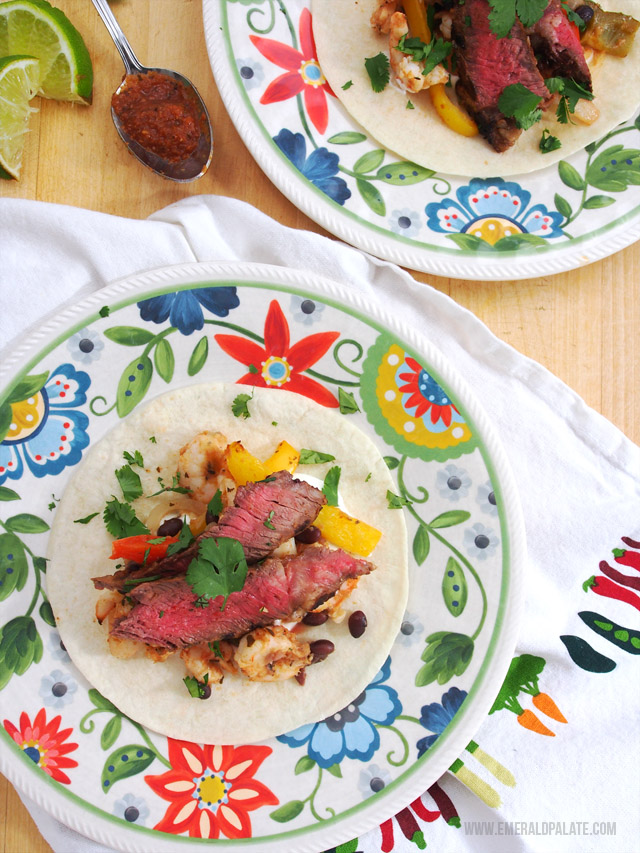
What are you most proud of?
Kirsten: Definitely that this is actually making an impact on people’s lives. When I get someone’s feedback, “God I didn’t think there was anything out there I could rely on that was healthy,” or “I didn’t think I could cook, but now I can,” that means the world to me. That’s what it’s all about. The thought that these sauces are on someone’s table, they’re eating it on their table right now…it’s so intimate and special. It’s so unbelievable.
What’s next for Mesa de Vida?
Kirsten: We want to continue to expand the line. I’m developing a Mediterranean sauce, we’ll continue to launch that. We’re definitely planning to spread across the nation. Some exciting online platforms are picking us up.
I also want to start creating more cooking videos. I want our websites to be somewhere that people don’t just go to buy a sauce or look up recipes on how to use the sauce. And I want it to be a place that people come to learn a healthy technique. We want to have a lot of strategies, tools and stories for people to get inspired.
What would people be surprised to learn about you?
Kirsten: I played piano for 12 years. And one of my secret indulgences is imitation crab. I know it’s so bad, but I love it!
If someone only had 24-hours in Seattle, what would you tell them to do?
Kirsten: If you’re new here, definitely Pike Place. I know it’s touristy, but it gives you such a good sense of Seattle and what we’re all about, especially because it’s the water. [Editor’s note: I have a guide to exploring downtown Seattle and Pike Place Market like a local so you can avoid the tourist traps].
Jumping over to the other side of the water is also a good idea. The city can get so crazy and I don’t like it when people think that’s representative of our city. I love when they can see all we have to offer: water, mountains, greenery, and all the diverse cultures. So take a foot ferry and hang out where it’s convenient, such as Bainbridge or Vashon Island.
My favorite Seattle restaurant is Bongos in Green Lake. It’s an old gas station that serves Caribbean and they’ve inspired me so much with their flavors. I studied it and cooked it, but when I went there I was blown away by their flavors. That and Manmoon is so special and good!
About the Creole Sauce I Used in This Recipe
I always like to taste ingredients as I go, so let me give you a rundown of what Mesa de Vida’s creole sauces tasted like by itself. You immediately taste the tomato and onion, followed by a deeply-roasted flavor…almost like you get from tomato paste. It’s very savory, which surprised me a bit because its packaging is similar to salsa and I anticipated a lighter, sweeter tomato taste.
As you finish, there’s a slow burn build up from the spices. Mesa de Vida’s website says this is “medium” spicy, but I’d say it’s more a mild-medium.
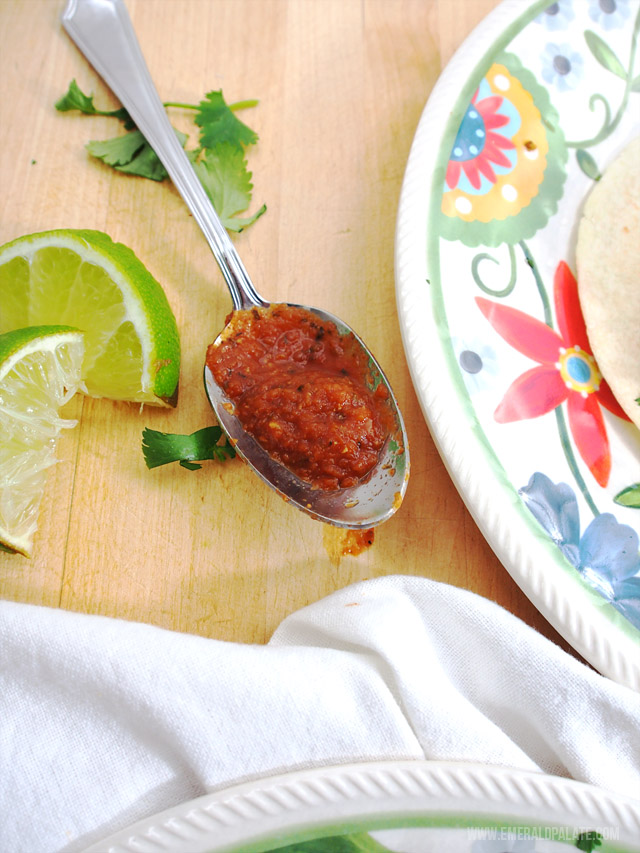
My favorite thing about the Mesa de Vida globally-inspired sauces is that you’ll recognize everything on the label. Seriously, it has things like “vinegar” and “celery”.
These are ingredients I use everyday in my kitchen packaged up into one convenient jar. It eliminates the need to roast a bunch of different (often expensive) spices and slowly add ingredients one at a time to build up depths of flavor. I often do this type of thing from scratch because I’m a purist like that and rarely use jarred sauces, but it means I only make these types of dishes on the weekends.
With Mesa de vida, I can get these types of flavors on the table any night of the week without feeling like I sold out to a jar because it’s literally as if I made the sauce ahead of time and put it in the fridge for later.
What does this fajita recipe taste like?
I love the combination of flavors in this fajita recipe. It’s bright and citrusy, but it has this earthiness and depth from the combination of roasted limes and steak. I highly recommend roasting the limes to add depth to the dish. It creates this slightly caramelized acidity, which is a toned down version of that lip-puckering sensation you get by tasting raw lime juice.
All of those sensations are just at the beginning of the bite. As you eat it, a slow build up of warm spices dance on your palate. You can really taste the depth of flavor in the creole-inspired sauce. The tomato and pepper add a toasty element that really plays nicely with the char on the steak and shrimp.
I really like pairing this dish with creamy elements, like avocado and sour cream. I think it cuts into the spice and acid nicely to make a well-balanced fajita. But you can pair it with any toppings you like!
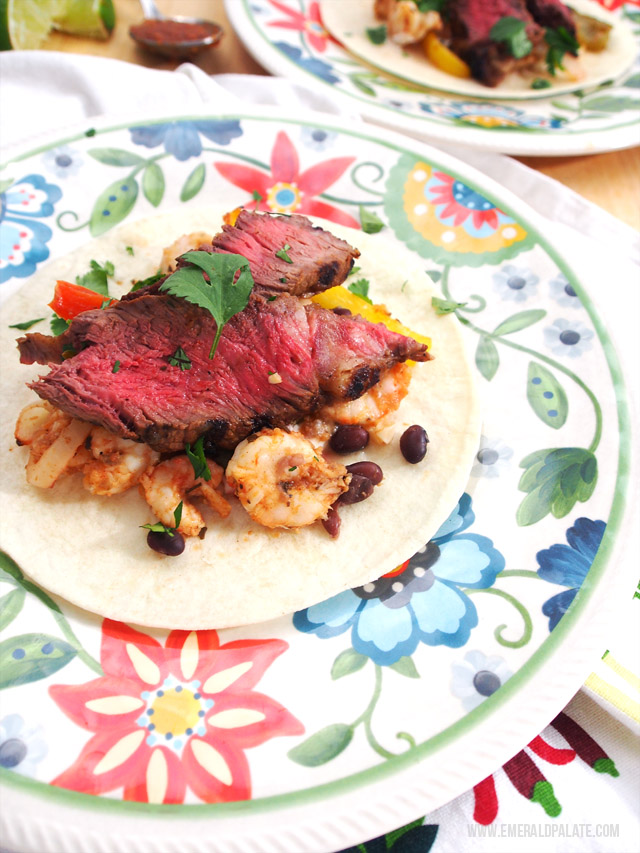
The Recipe
Serves 4 | Active 30 minutes | 45 minutes total
Ingredients:
- 1 lb. de-veined and peeled shrimp (tails removed)
- 1 lb. top sirloin steak (you can easily sub chicken to make this even more heart healthy!)
- 1, 9-oz jar Mesa de Vida creole-inspired cooking sauce (you can really use any of their cooking sauces for this recipe. I did it a second time with the smoky latin sauce and it was fantastic! You can get $4 off any jar if you use promo code EMERALD by March 31, 2018!).
- 2 limes, halved
- 1 Tbsp. extra virgin olive oil
- 1 medium onion, sliced 1/4″ thick
- 1 tsp. salt (you can also cut down the salt to taste to make this more heart healthy!)
- 2 small bell peppers, sliced 1/4″ thick (I like doing one yellow or orange & one red)
- 2 cloves garlic, minced
- 1, 15.5 oz. can of black beans, drained, rinsed, & dried (I highly recommend a can with no-salt added)
- 1/2 C fire-roasted frozen corn
- 4-8 flour tortillas (depends on size you buy)
- 1/2 C cilantro leaves, roughly chopped
- Sour cream for serving (optional)
- 1/2 avocado, chopped for serving (optional)
Directions:
Step 1
Place the shrimp and steak in a large bowl. Pour in 1/2 of the jar of the Mesa de Vida creole sauce into the bowl and massage it into the shrimp and steak. Cover with plastic wrap and place in the fridge to marinade for at least 20 minutes (I like to prep and cook everything else while it marinades).
Step 2
Meanwhile, preheat the oven to 400°F. Add a cast iron grill pan to it as it heats up.
Step 3
Add the lime halves cut side down to a cookie sheet and bake for ~20 minutes until charred. You can also use the broiler for less time if you have a good boiler, but alas, mine is kind of crappy.
Step 4
Heat the extra virgin olive oil over medium heat in a cast iron skillet. Once shimmering, add the sliced onion and 1/8 tsp. salt. Cook until they start to get golden, 5-7 minutes.
Step 5
Add the sliced peppers and another 1/8 tsp. salt. Cook until softened, 3-5 minutes.
Step 6
Add the minced garlic and cook until fragrant, 1 minute.
Step 7
Add the remaining 1/2 jar of Mesa de Vida creole-inspired sauce and mix into the onion-pepper mixture. Add the drained black beans, roast corn, and 1/2 tsp. salt. Cook until warmed through and bubbling, 5 minutes. Squeeze one of the lime halves on the mixture when it’s out of the oven, mix, and set aside on low heat until ready to use.
Step 8
Meanwhile, turn the stove up to medium-high heat. Take the steak out of the marinade and season with 1/8 tsp. of salt. Take the cast iron grill pan out of the oven and add it to the stove. Add the steak to the grill pan and cook on each side for about 4-5 minutes so a nice brown crust forms. Make sure not to touch it so it has a chance to do it’s thang!
Step 9
Once the steak is browned, take the grill pan and add it back to the oven, cooking the steak to 140°F for medium-rare, 6-8 minutes (it will come up a couple degrees as it rests). Set aside on a cutting board to rest for about 10 minutes.
Step 10
As the steak rests, turn the heat on the stove to medium. Season the shrimp with 1/8 tsp. salt. In the same grill pan you used for the steak, add the shrimp. Cook for 2-3 minutes until pink, flipped once halfway through. You may have to do the shrimp in batches so as not to overcrowd the pan. Remove from pan and set aside.
Step 11
Once the steak had a chance to rest, slice it against the grain on a diagonal into about 1/4″ strips.
Step 12
Have each person microwave their tortilla for 15 seconds. Lay it flat and add sour cream (if desired), the fajita mixture, some shrimp, and some steak to each. Top with avocado and cilantro if desired. Fold up and enjoy!
Nutritional Information Per Serving:
(Based on 1 large tortilla per serving. Excludes sour cream and avocado.)
Calories: 706 | Calories from fat: 103 | Fat: 17.25g | Saturated fat: 6g | Cholesterol: 236mg | Sodium: 1,280mg | Carbs: 62.2g | Fiber: 11.4g | Sugars: 8.6g | Protein: 46.7g
Pin This Fajita Recipe for Later
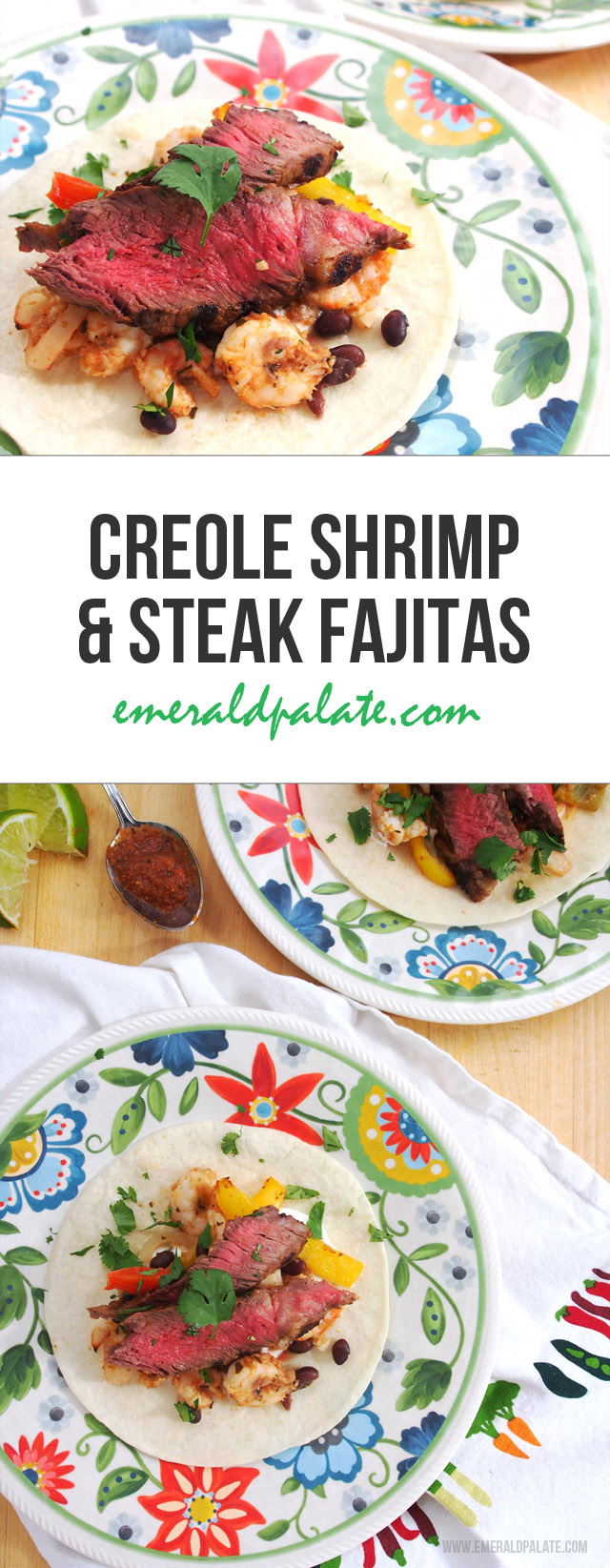
Nutritional Facts Disclaimer: I am not a registered nutritionist and therefore these numbers are approximate. I researched the serving sizes and facts for each ingredient in this recipe (mostly using the manufacturer labels and this site), but slight variations in things like seasoning, garnishes, and substitutions can change the nutritional information. Use this information only as a general indication of your nutritional intake.
Post Disclaimer: Mesa de Vida provided me with a free sauce set in exchange for including it in a recipe. As always, all opinions and recipe ideas are my own. Thank you for supporting the brands that help make The Emerald Palate possible!
